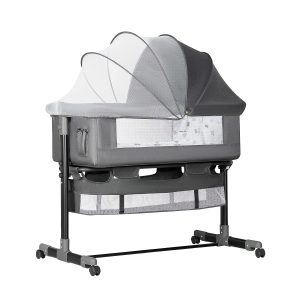
Is Co-Sleeping With Your Baby A Good Idea?
Co-Sleeping: Exploring the Benefits, Safety, and Cultural Perspectives
Few parenting subjects spark as much controversy as co-sleeping—the practice of sharing a sleeping space with your child. The decision to co-sleep involves various factors, including safety concerns and cultural differences in sleeping habits. This thorough guide explores the advantages, safety concerns, and cultural views of co-sleeping to provide parents with a more nuanced understanding of this personal parenting decision.
 Incorporating Research Findings: Benefits of Co-Sleeping
Incorporating Research Findings: Benefits of Co-Sleeping
Evidence for the benefits of co-sleeping has been mounting in recent years, with several studies highlighting the importance of this practice in helping parents and children develop strong bonds. According to research by developmental psychologists, sharing a bed with a baby or young child might help them feel more secure and close to you. Babies who slept next to their parents had lower levels of the stress hormone cortisol, suggesting they were more comfortable and safe, according to research published in the Journal of Developmental & Behavioural Paediatrics. Also, prominent sleep expert Dr James McKenna stresses the significance of what he calls a “breast sleeping” environment, where nursing and sharing a bed simultaneously meet emotional and nutritional needs.
Addressing Concerns: Safety Considerations for Co-Sleeping
While addressing common concerns surrounding safety is vital, it is also essential to acknowledge the compelling benefits of co-sleeping. One of the most significant concerns that parents could have is the possibility of Sudden Infant Death Syndrome (SIDS), which is linked to the practice of co-sleeping arrangements. On the other hand, studies have shown that when done safely, co-sleeping can lower the incidence of sudden infant death syndrome (SIDS). According to Dr Rachel Moon, a paediatrician and a specialist in sleep-related baby mortality, room-sharing without bed-sharing is the safest sleep environment for newborns. She emphasises the need for a hard sleep surface and reminds parents to avoid using soft bedding. Implementing safeguards such as removing heavy blankets and pillows from the sleeping space and ensuring that the surface on which the individual is sleeping is free of any potential dangers will reduce the likelihood of any potential risks.
 Practical Tips: Creating a Safe Co-Sleeping Environment
Practical Tips: Creating a Safe Co-Sleeping Environment
To provide a safe atmosphere for co-sleeping, it is necessary to carefully consider the room’s arrangement and adhere to the safety recommendations. An investment in a co-sleeper bassinet or cot that can be attached securely to the parent’s bed is a helpful piece of advice. This will give the newborn a distinct resting place while allowing easy access to the parent’s bed for feedings at night. It is recommended by Dr Harvey Karp, a well-known paediatrician and author of “The Happiest Baby on the Block,” that a firm mattress with a fitted sheet is used and that loose bedding or soft materials that might potentially cause suffocation be avoided. Other important factors for safe co-sleeping include ensuring that the newborn is positioned on their back when sleeping and preventing the infant from overheating by ensuring the room temperature is suitable.
Personal Perspectives: Stories from Co-Sleeping Families
Parents who have adopted the practice of co-sleeping often talk about the great experiences they’ve had and the insights they’ve gained about the advantages it has brought to their family. In her experience as a mother of two, Sarah recounts how co-sleeping made it easier for her to nurse her children and strengthened the connection she shared with them. Similarly, David, a father, emphasises the ease of keeping his baby son close for evening calming by stating that it reduces overall sleep interruptions for the entire family. In addition to providing reassurance to parents contemplating using this sleeping arrangement, these personal experiences emphasise the emotional and practical benefits of co-sleeping the children.
Cultural Variations: Diversity in Co-Sleeping Practices
It is essential to acknowledge that different cultures have different perspectives on the practice of co-sleeping and that successful arrangements for one family might not be appropriate for another. Co-sleeping is a widespread habit that is firmly entrenched in the sense of familial intimacy and community living that is prevalent in many Asian Asian cultures. On the other hand, Western civilizations frequently emphasise independence and autonomy, resulting in diverse viewpoints towards co-sleeping. Parents can make educated judgements that follow their values and beliefs while still putting the well-being of their children as their top priority if they acknowledge the diversity of cultures and respect the preferences of individuals.
Supporting Evidence: Research on Improved Sleep Patterns
A continuous body of research demonstrates the beneficial effects of co-sleeping on the sleep patterns of children as well as the general quality of their sleep. According to a study carried out by sleep experts, babies who share a sleeping space with their parents tend to have fewer awakenings during the night and longer intervals of restorative sleep. Dr William Sears, a paediatrician and advocate for attachment parenting, strongly emphasises the function that nocturnal proximity plays in regulating the sleep-wake cycles of newborns and encouraging more profound sleep. Furthermore, studies that follow children over time have demonstrated that children who sleep alongside their parents throughout infancy are likelier to establish healthy sleeping patterns and suffer fewer sleep problems later in life.
Expert Recommendations: Strategies for Smooth Transitions
In the course of their children’s development, many parents find themselves contemplating the possibility of introducing them to autonomous sleeping arrangements. Dr Jodi Mindell, a clinical psychologist specialising in paediatric sleep, recommends progressively introducing separate sleeping areas while preserving evening intimacy through bedtime routines and regular reassurance. This is accomplished by gradually introducing separate sleeping spaces. A transitional item, such as a cherished blanket or stuffed animal, may greatly assist to provide comfort and familiarity throughout this adjustment period. Furthermore, Dr Mindell recommends that parents have open and honest conversations with their children about the transition, acknowledging any worries or anxieties their children may have while providing them gentle encouragement and support.
Long-Term Benefits: Building Resilience and Independence
After some time has passed, co-sleeping can help youngsters develop independence and resiliency, contrary to the fears associated with it. Dr. Mary Ainsworth, a pioneer in attachment theory, emphasises the significance of a solid basis in early life for developing autonomy and self-confidence in children. Parents may encourage their children to explore and manage their emotions independently by creating a secure and supportive sleeping environment. This lays the basis for good emotional regulation in their children. Children eventually transition to sleeping independently with a strong sense of security and self-assurance as they develop more secure in their capacity to self-soothe and regulate their sleep habits. This occurs when children gradually become more capable of managing their sleep routines.
Embracing Diversity in Parenting Choices
When co-sleeping with your child, the decision is highly personal. Various variables impact it, such as cultural conventions, individual preferences, and practical concerns. Parents can make educated decisions that prioritise the well-being of their children and develop a strong link between themselves and their children by comparing the benefits of co-sleeping against the safety issues concerned with it. Whether you choose to have, children share a room or investigate the possibility of autonomous sleeping arrangements, the most important thing is to establish a caring atmosphere in which children may feel loved, safe, and supported as they work towards developing healthy sleeping habits. We can create a culture that supports all children and allows them to flourish if we acknowledge the diversity of parenting styles and respect each family’s specific requirements.
References
- McKenna, James J., and Thomas McDade. “Why babies should never sleep alone: A review of the co-sleeping controversy in relation to SIDS, bedsharing and breast feeding.” Paediatric respiratory reviews 6, no. 2 (2005): 134-152.This reference provides a comprehensive review of the co-sleeping controversy, discussing its relation to Sudden Infant Death Syndrome (SIDS), bed-sharing, and breastfeeding. It supports the article’s discussion on the benefits and safety considerations of co-sleeping.
- Moon, Rachel Y., and Task Force On Sudden Infant Death Syndrome. “SIDS and other sleep-related infant deaths: evidence base for 2016 updated recommendations for a safe infant sleeping environment.” Pediatrics 138, no. 5 (2016): e20162940.This Pediatrics article offers evidence-based recommendations for creating a safe sleep environment for infants, including guidelines on room-sharing without bed-sharing. It supports the article’s section on safety considerations for co-sleeping.
- Mindell, Jodi A., et al. “A nightly bedtime routine: impact on sleep in young children and maternal mood.” Sleep 32, no. 5 (2009): 599-606.This Sleep study explores the impact of a nightly bedtime routine on children’s sleep patterns and maternal mood, providing insights into strategies for smooth transitions to independent sleeping arrangements. It supports the article’s discussion on expert recommendations for transitioning children to independent sleep.
The post Is Co-Sleeping With Your Baby A Good Idea? appeared first on Totally Babies.
The Article Is Co-Sleeping With Your Baby A Good Idea? Was Found On https://limitsofstrategy.com
The Article Is Co-Sleeping With Your Baby A Good Idea? First Appeared ON
: https://ad4sc.com










